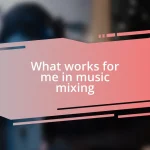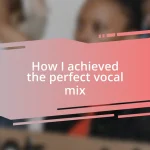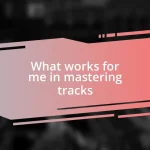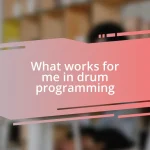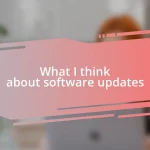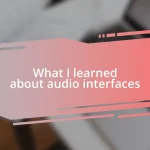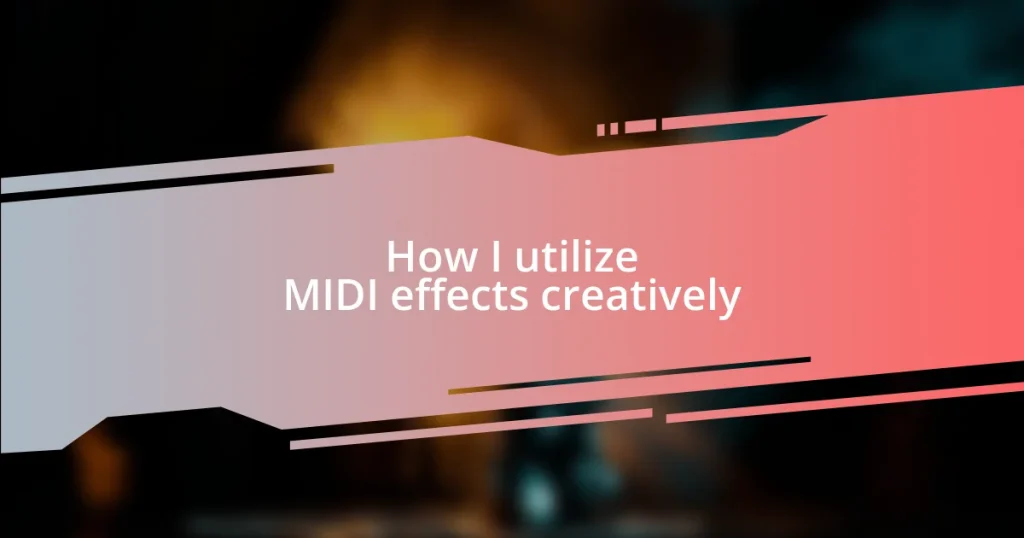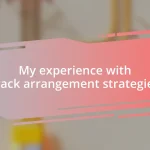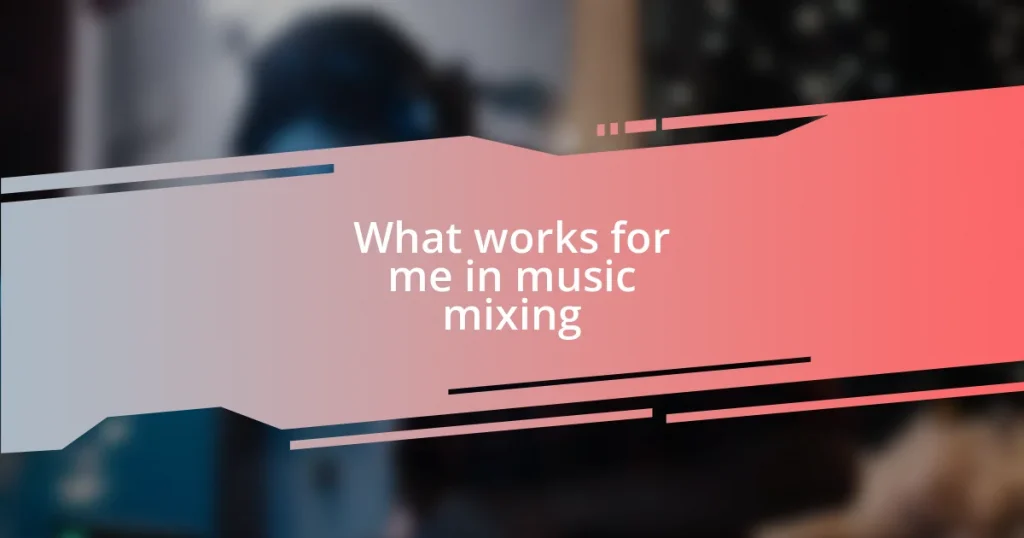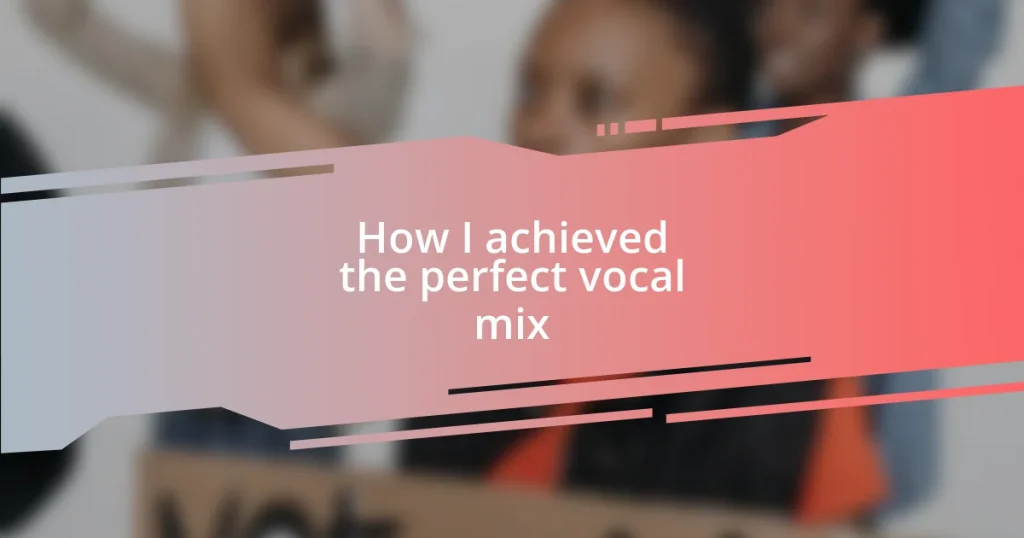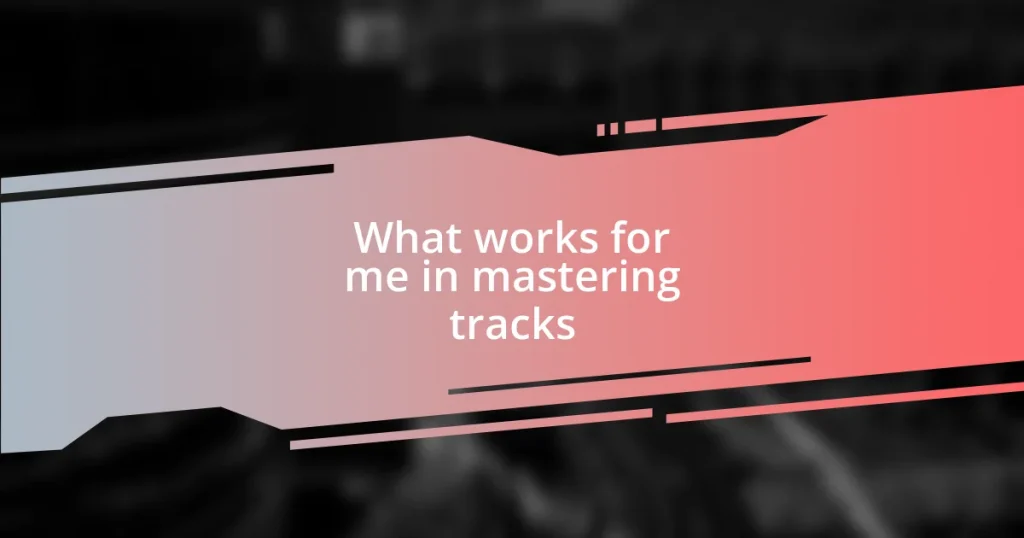Key takeaways:
- MIDI effects, like arpeggiators and randomizers, can enhance creativity and introduce unique elements in music composition.
- Experimenting with layering different MIDI effects can produce rich, complex sounds and transform straightforward tracks into captivating pieces.
- Real-time modulation and unconventional uses, such as integrating rhythms with harmonics, can lead to groundbreaking musical discoveries and engaging performances.
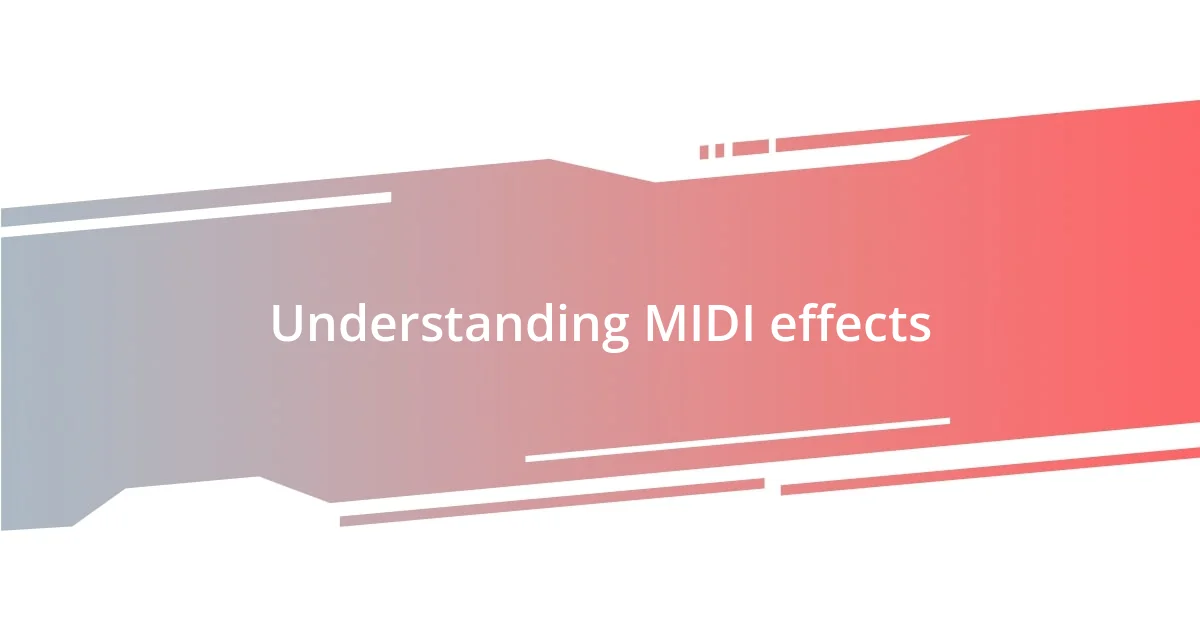
Understanding MIDI effects
MIDI effects are fascinating tools that manipulate MIDI data before it reaches your instruments. Imagine a magical layer that transforms your simple notes into complex patterns or adds variations that breathe life into your compositions. Have you ever felt a bit stuck in your creativity? MIDI effects can be the spark you need to unlock new ideas.
One of my favorite MIDI effects is the arpeggiator. It allows me to take a single chord and turn it into a flowing sequence of notes. The first time I used it, I felt a wave of excitement wash over me as I heard my chord evolve into something vibrant and dynamic. It’s almost like watching a seed blossom into a flower right in front of you.
I often wonder why more musicians don’t dive deeper into MIDI effects. They offer a level of creative freedom that’s hard to match. For example, using a randomizer can introduce delightful surprises to your melodies that you might not have considered. I remember using it during a late-night session, and the unexpected results turned my track into something I never imagined, filled with playful nuances that felt almost alive.
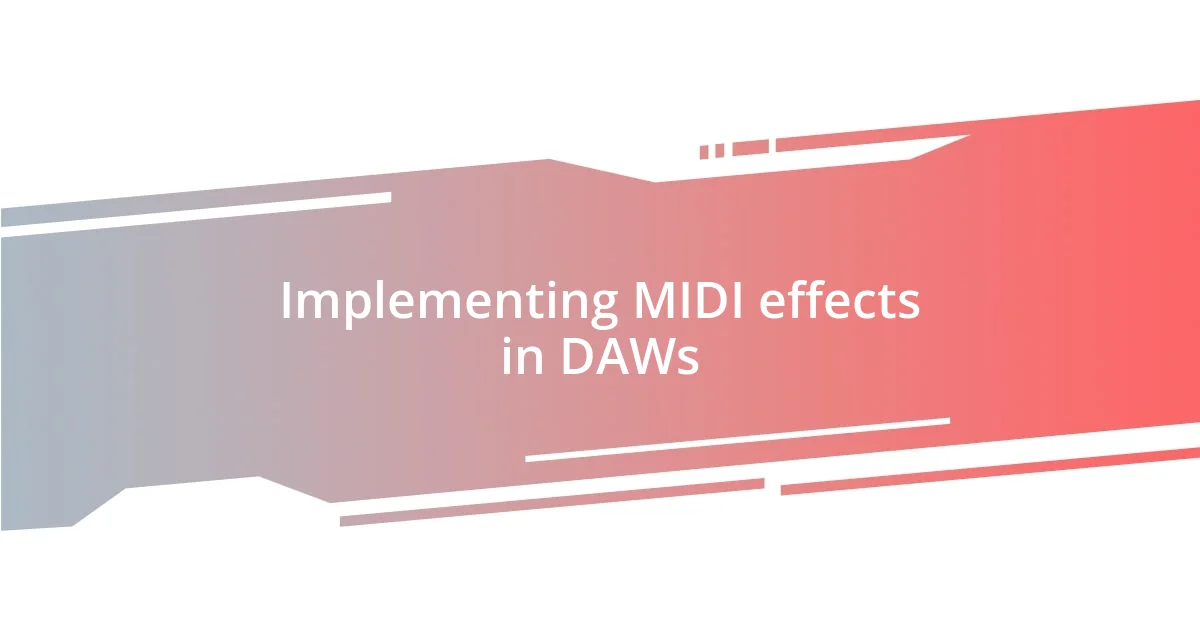
Implementing MIDI effects in DAWs
Implementing MIDI effects in a DAW can be quite an exhilarating experience, and it’s also incredibly straightforward once you get the hang of it. I remember the first time I opened my DAW and experimented with MIDI effects—there was a rush of possibility. Most DAWs have a dedicated MIDI effects section, and the key is exploring each effect to see how it can reshape your sound. With just a few clicks, you can modify velocity, timing, and even create rhythmic shifts that add a stunning edge to your tracks.
Here are some common steps for implementing MIDI effects in your DAW:
- Select the Midi Track: First, highlight the track where you want to apply the MIDI effects.
- Insert the Effect: Choose a MIDI effect from your DAW’s list of plugins and insert it onto the track.
- Adjust Parameters: Play around with settings; small tweaks can lead to entirely new sounds.
- Experiment with Order: Sometimes moving effects around in the chain can produce surprising results.
- Record and Modify: After applying the effect, record your performance and make further adjustments as necessary.
Every time I dive into MIDI effects, I find that each session feels unique, like an adventure waiting to unfold.
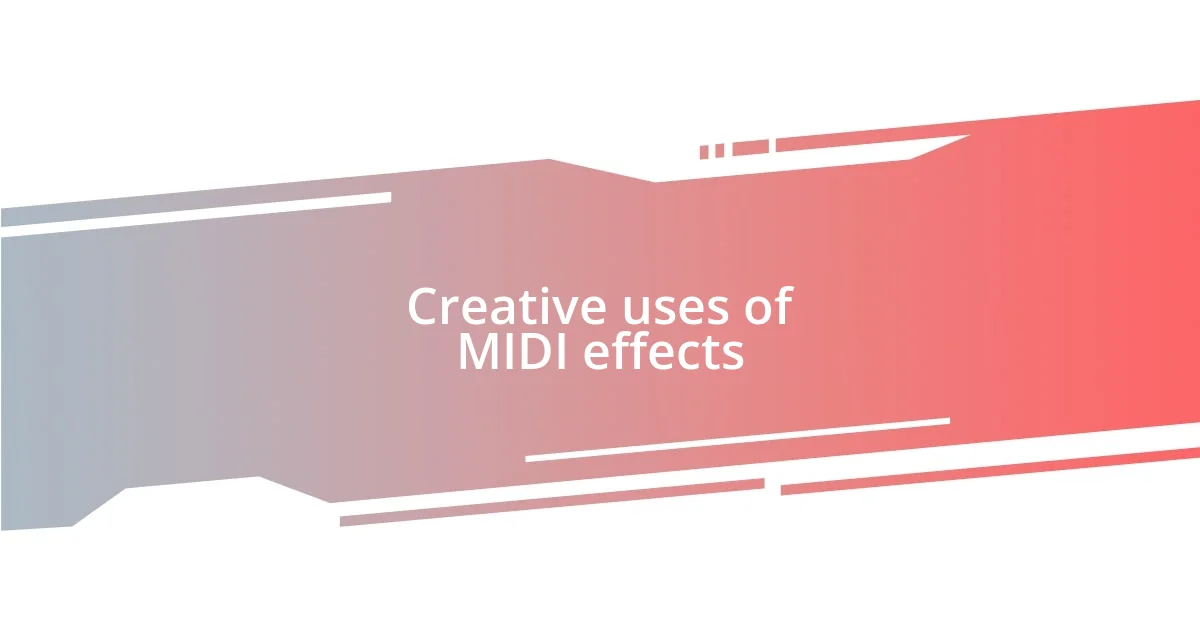
Creative uses of MIDI effects
Utilizing MIDI effects can lead to some truly imaginative outcomes in music composition. For instance, I often use chord triggers to rapidly switch between different chord voicings. This creates an engaging tapestry of sound that can shift the emotional tone of a track in mere moments. I once hosted a jam session where I unleashed a chord trigger on a bassline, and the resulting harmonic shifts kept everyone mesmerized. It’s incredible how a simple twist like this can completely reshape the vibe.
I’ve also found creative ways to utilize MIDI effects for sound design, especially with pitch shifting. I recall a time when I used a pitch shifter to create a vocal-like texture from a synth. The result was haunting and ethereal, evoking feelings of nostalgia and mystery. This unexpected sound sparked an entirely new direction for my project, showcasing how a little experimentation can lead to groundbreaking ideas.
Lastly, effects like the note repeater serve a dual purpose; they can generate rhythmic complexity that enhances a melody’s groove. One night, experimenting with a repeater led me to create a catchy hook that I couldn’t stop humming. It was like discovering a new musical language that spoke to me and transformed my production process. These creative applications remind me of the infinite possibilities that MIDI effects bring to the table.
| MIDI Effect | Creative Use |
|---|---|
| Arpeggiator | Transforms chords into dynamic sequences |
| Chord Trigger | Creates harmonic shifts for emotional impact |
| Pitch Shifter | Designs unique textures and soundscapes |
| Note Repeater | Generates rhythmic complexity and catchy hooks |
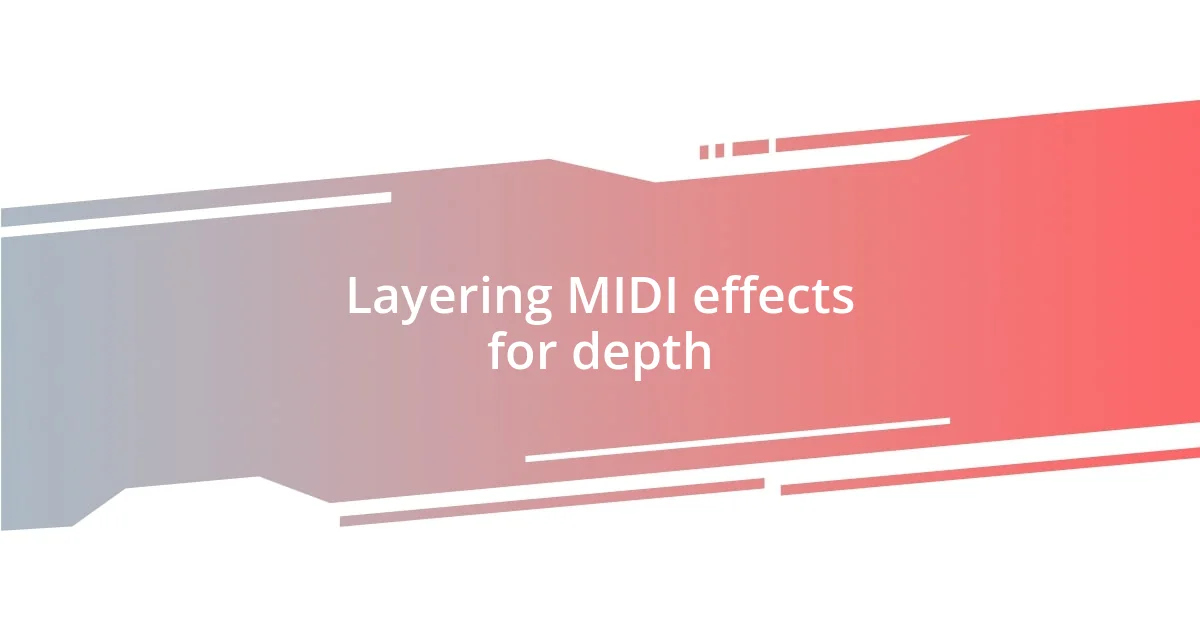
Layering MIDI effects for depth
Layering MIDI effects can truly elevate your sound by adding unexpected depth and complexity. I often find myself stacking arpeggiators on top of one another. Each one contributes its unique flair, creating swirling patterns that pull the listener into a rich sonic landscape. It’s like painting with sounds—one brushstroke can change the entire picture.
One time, I layered a chord trigger with a velocity effect, and the outcome was delightfully impressive. As the chord changes cascaded, the varying dynamics added an emotional ebb and flow that gave the track an almost cinematic quality. I remember feeling a rush, thinking how this simple combination transformed an otherwise straightforward progression into a compelling story.
Have you ever tried using different effects in conjunction? For instance, I like to pair a note repeater with a delay effect. The result can be so intricate, recreating rhythms that pulse and dance, wrapping around the main melody. This intertwining creates a captivating auditory experience, drawing listeners in closer. Each added layer is like an extra character in a play, enriching the narrative of the music.
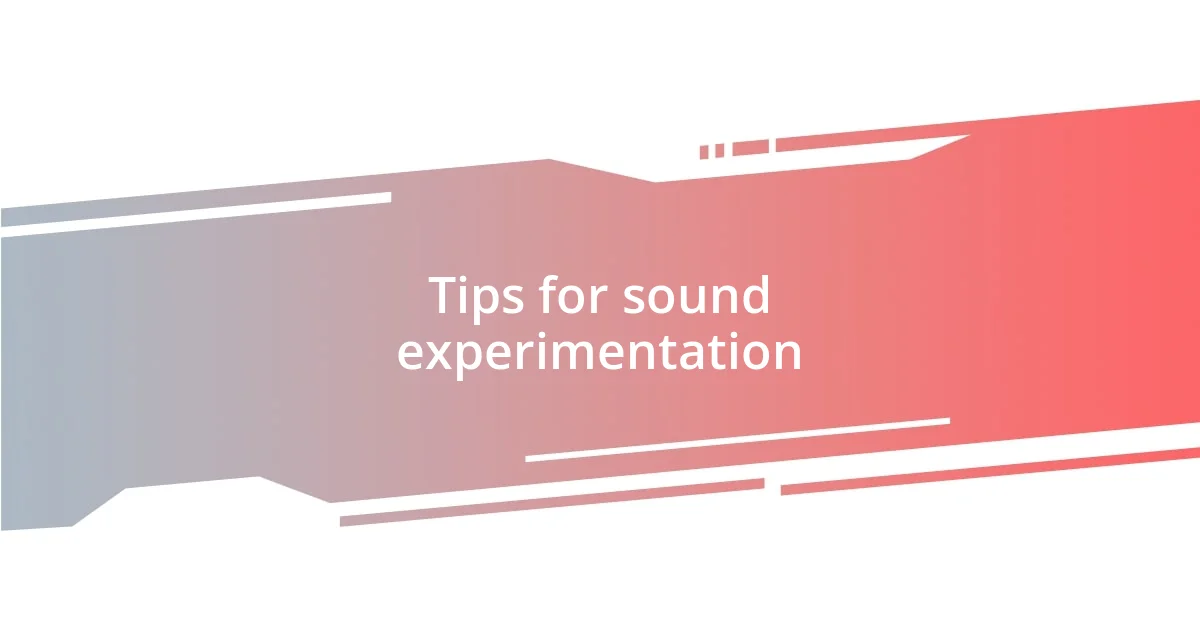
Tips for sound experimentation
Experimentation is where the magic truly happens. One technique that has served me well is to modulate effects in real time while recording. I once set up my MIDI controller to tweak a reverb parameter on a synth pad, and as I moved the knob, the sound morphed in ways I never anticipated. This hands-on approach made the entire process feel organic, turning a simple pad into a lush, evolving soundscape that captivated my audience.
I love to explore unconventional timbres with MIDI effects. For instance, I sometimes route a drum kit through a chord trigger to see what happens when rhythm becomes harmonic. The first time I did this, the result was a funky, melodic groove that gave the beat a whole new character. It made me realize that stepping outside of traditional boundaries can yield delightful surprises.
Another aspect I enjoy is incorporating chance into my experimentation. I often use randomization features found in MIDI effects to generate unexpected elements. One night while playing, I activated a randomizer for note velocities, which created a jagged, unpredictable dynamic that felt exhilarating. Have you ever let randomness steer your creative direction? This playful attitude can lead to discoveries that feel fresh and vibrant, opening doors to new sonic possibilities you might have never considered before.
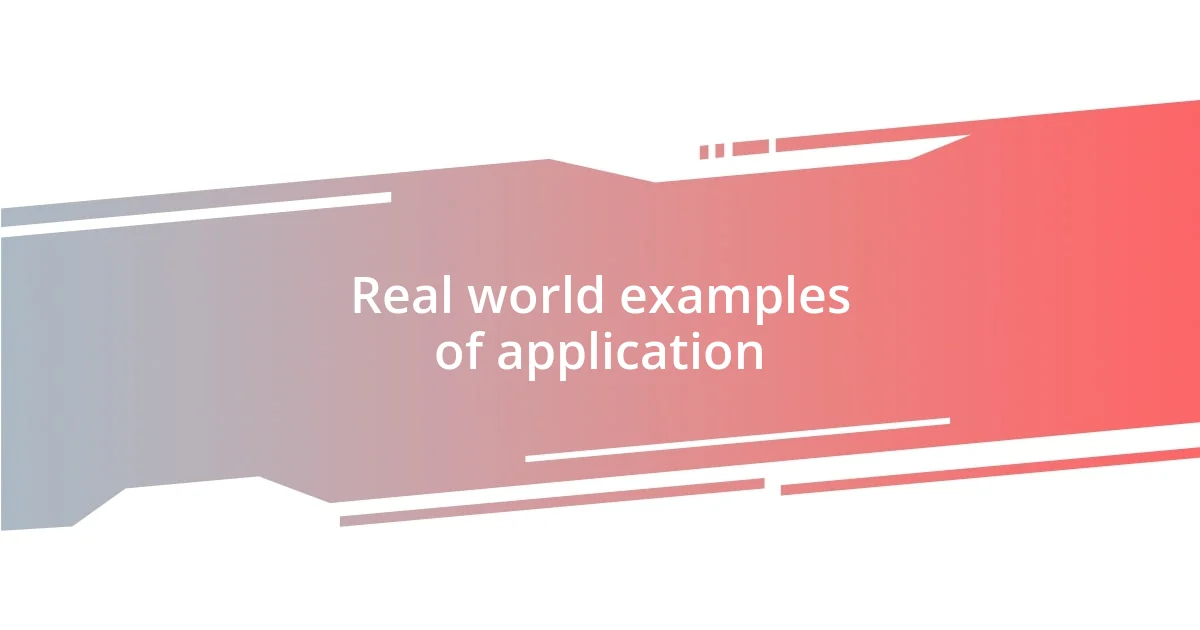
Real world examples of application
One of my favorite practical applications of MIDI effects occurred during a jam session with friends. We wanted to create an upbeat track, so I decided to utilize a MIDI arpeggiator combined with a filter effect. As I played, the arpeggiator generated a sequence that danced around the chords while the filter dynamically opened and closed. The room lit up with excitement as we almost instantly felt the energy shift—it transformed the vibe from casual to seriously engaging.
In another project, I experimented with a MIDI chord generator, layering it with a sustain effect on a lead synth. I remember the moment when that sustained note blended beautifully with the rhythmic pulses underneath; it felt like a blissful union. It not only supported the melodic line but also provided an atmospheric backdrop that made the entire piece sound more cohesive. Have you ever experienced that feeling when everything seems to just fit perfectly together? It’s like discovering that missing puzzle piece you didn’t even know you were looking for.
Sometimes, I push the envelope by using MIDI effects creatively in live performances. At a recent gig, I triggered a MIDI sequencer to manipulate drum sounds in real-time. Just before I was about to drop the beat, I activated a pitch shift that elevated the energy right when the audience least expected it. The thrill of seeing their surprised faces reminded me just how powerful and engaging these tools can be when used in the heat of the moment. It’s this type of spontaneity that keeps both the performer and the audience on their toes, creating unforgettable shared experiences.
